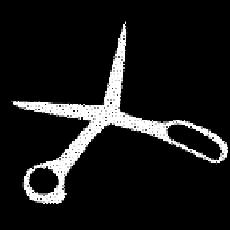Image Processing Reference
In-Depth Information
operations for preprocessing of the object. For example, instead of starting
from level 1 in Step 2 of the algorithm SMAT, we may initiate processing
from a deeper level and delete all the object points in the outer layer till that
level in the beginning of Step 1. An example of a thinned pattern is shown
in Fig. 6.9(f). We have deleted all the object pixels that are at a distance of
1 before applying the algorithm. As a result, we find that isolated points are
removed in the thinned pattern. However, we should note that the thickness of
the pattern may be more than one pixel, due to the retainment of the RCMD.
6.4 Geometric Transformation
Geometric transformation of a binary object could be trivially carried out
by applying the transformation on the coordinates of each object point (fore-
ground point). However, it involves a significant amount of computation, which
is proportional to the number of object points. Moreover, due to discretization
of transformed coordinates, there could be gaps or empty pockets created in
the transformed objects as shown in Fig. 6.11(b).
(a)
(b)
(c)
FIGURE 6.11: (a) Scissors, (b) rotated by 75
o
with pixel representation,
and (c) rotated by 75
o
with MAT.
The MAT is a useful representation for performing geometric transforma-
tion [129] e
ciently and rendering the object using e
cient display routines
of polygon filling in a graphics environment. A typical example is shown in
Fig. 6.11 (c). In this case, the same transformation is applied to the vertices
of medial circles, which are convex polygons in the digital metric space. If an
object contains n pixels, geometric transformation takes place in O(n) time
complexity, whereas for an object with k medial disks, it runs in O(k) time
complexity. As k ≪ n, the latter algorithm runs much faster. However, for
the purpose of reconstruction, it is required to fill the polygons. This would











